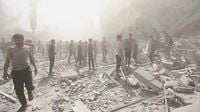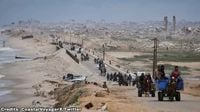In the early hours of September 18, 2025, the Gaza Strip was once again rocked by a series of explosions as Israel’s military offensive intensified, sending shockwaves through a region already devastated by nearly two years of conflict. According to Gaza’s Health Ministry, the Palestinian death toll has now surpassed a staggering 65,000, with women and children making up about half of the fatalities. The humanitarian crisis in Gaza continues to spiral, with experts warning that Gaza City is now experiencing famine and the vast majority of its population displaced.
Israeli troops and tanks pushed deeper into Gaza City this week, marking a renewed and forceful ground offensive that began on Monday, September 15. The Israeli military reported that its air force and artillery units struck Gaza City more than 150 times in the days leading up to September 18, toppling high-rise towers that, according to Israeli officials, were being used as military observation points by Hamas. The scale of destruction has been immense, with entire neighborhoods reduced to rubble and critical infrastructure, including hospitals and communications networks, severely compromised.
Phone and internet services across northern Gaza were severed by Israeli strikes, regulators said, effectively cutting off tens of thousands of Palestinians from the outside world. The Palestinian Telecommunications Regulatory Authority, based in the occupied West Bank, confirmed that Israeli strikes on main network lines had left many residents unable to call for help, coordinate evacuations, or share details of the ongoing military operations. The Associated Press reported that their attempts to reach contacts in Gaza City were unsuccessful, underscoring the isolation now faced by those trapped inside the conflict zone.
Since the start of this latest ground offensive, approximately 500,000 Palestinians have fled Gaza City, according to data from the Israel Defense Forces (IDF). Israeli officials estimate that more than 350,000 have left since evacuation warnings began, with many streaming south by car or on foot. In a rare move, Israel opened a corridor south of Gaza City for two days starting at noon on September 17 to allow further evacuations. Despite these efforts, the United Nations and aid organizations warn that 90% of Gaza’s population has now been displaced, and humanitarian conditions are catastrophic.
Overnight strikes on September 17 claimed the lives of at least 16 people, including women and children, according to hospital officials. The Gaza Health Ministry noted that the total number of wounded since the start of the war in October 2023 has reached 165,697. The ministry, which is part of the Hamas-run government, does not distinguish between civilian and militant casualties in its tallies, but its figures are widely cited by the UN and independent experts as reliable estimates.
The origins of the current war trace back to October 7, 2023, when Hamas-led militants stormed into southern Israel, killing around 1,200 people—mostly civilians—and abducting 251 others. Since then, Israel has launched multiple large-scale raids into Gaza City, only to see militants regroup. This time, Israeli leaders have pledged to take full control of the city, which they describe as the “central hub” of Hamas power. The Israeli military has stated its goal is to “destroy Hamas’ military infrastructure,” though it has not provided a clear timeframe for the operation.
The latest escalation has drawn intense international scrutiny and condemnation. On September 17, Qatar’s Ministry of Foreign Affairs released a statement condemning Israel’s ground offensive as an “extension of the war of genocide” against Palestinians. The statement, posted on X (formerly Twitter), came just a day after a UN commission of experts found Israel was committing genocide in the Palestinian enclave—a charge Israel firmly denies. In a joint statement, a coalition of over 20 leading aid organizations, including the Norwegian Refugee Council, Anera, and Save the Children, called on the international community to take stronger action: “What we are witnessing in Gaza is not only an unprecedented humanitarian catastrophe, but what the UN Commission of Inquiry has now concluded is a genocide. States must use every available political, economic and legal tool at their disposal to intervene. Rhetoric and half measures are not enough. This moment demands decisive action.”
Hospitals, already overwhelmed by casualties and shortages of medicine and supplies, have not been spared from the violence. The Gaza Health Ministry reported that multiple Israeli strikes hit the Rantisi Hospital for children in Gaza City on the night of September 16. Photographs circulated by the ministry showed a damaged roof, shattered water tanks, and rubble strewn through hospital corridors. The strikes forced half of the hospital’s 80 patients to flee, while about 40 patients—including four children in intensive care and eight premature babies—remained with 30 medical workers. Fikr Shalltoot, Gaza director for Medical Aid for Palestinians, said, “This attack has once again shattered the illusion that hospitals or any place in Gaza are safe from Israel’s genocide.” The Israeli military responded that it was reviewing the incident and reiterated that it does not deliberately target public communication networks or civilian infrastructure, maintaining that it takes steps to mitigate harm to civilians while targeting “terrorist organizations.”
Meanwhile, the plight of hostages held by Hamas remains a deeply emotional and divisive issue within Israel. On September 17, protesters dressed in white, symbolizing hostages killed during the war, gathered near Prime Minister Benjamin Netanyahu’s residence in Jerusalem. They held a banner reading “This is Sparta,” referencing a recent speech by Netanyahu in which he described protesters as “Super Sparta.” Among them was Michel Iluz, whose son remains among the 48 hostages still believed to be in Gaza. Lying on the ground beside the demonstrators, Iluz demanded the return of his son’s body for burial. Addressing the crowd, he declared, “We will fight for the return of our children and the restoration of the Israeli ethos. You will be with us here; we will set up a tent city here, everywhere here. We will sleep here; we will sleep here and stay here and make our voices heard before the Prime Minister, who betrayed us and the values on which we were raised.”
Political tensions within Israel have also been fueled by controversial remarks from far-right finance minister Bezalel Smotrich. Speaking at an urban-renewal conference in Tel Aviv, Smotrich described Gaza as a potential “real estate bonanza” and revealed that he had submitted a “business plan” to former U.S. President Donald Trump for sharing proceeds from redevelopment of the territory. “We paid a lot of money for this war, so we need to divide how we make a percentage on the land marketing later in Gaza,” Smotrich said, adding, “And now, no kidding, we’ve done the demolition phase, which is always the first phase of urban renewal. Now we need to build. It’s much cheaper.” Smotrich, a key ally in Netanyahu’s coalition, advocates for the continued war until Hamas is eradicated, the relocation of much of Gaza’s population to other countries through what he calls “voluntary emigration,” and the rebuilding of Jewish settlements dismantled in 2005.
As the smoke continues to rise over Gaza and the world watches with growing alarm, the conflict shows no sign of abating. The toll on civilians, the destruction of infrastructure, and the deepening political divides both within Israel and internationally make clear that the path to peace remains as elusive as ever.





